From 4 to 11 July 2025, EFSP follows the 44th edition of Le Giornate del Cinema Muto. The Italian town of Pordenone is again the location for the world’s leading international silent film festival. On today's programme is one of the 'Rediscoveries': Die Dame mit der Maske / The Lady with the Mask (Wilhelm Thiele, 1928). It was only the second film of lovely Dita Parlo (1906-1971). During the late 1920s and 1930s, Parlo was a star of German and French films, who also worked in Hollywood. Decades later, she inspired both Dita Von Teese and Madonna, the latter used her name and character from the classic L'Atalante (1934) for her 'Sex' book and 'Erotica' album.
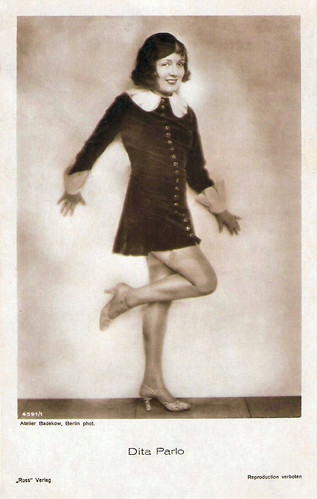
German postcard by Ross Verlag, no. 4591/1, 1929-1930. Photo: Atelier Badekow, Berlin.

German postcard by Ross Verlag, no. 4591/2, 1929-1930. Photo: Angelo Photos.

British postcard in the Picturegoer Series, London, no. 444. Photo: Ufa / Harlip.
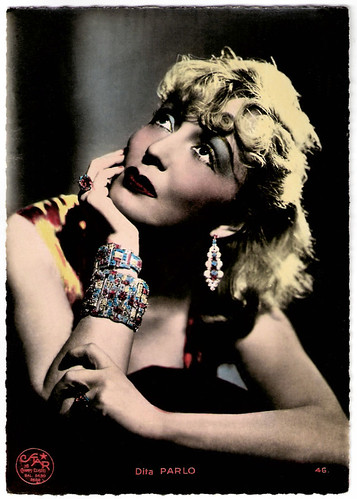
French postcard by Editions O.P., Paris, no. 46. Photo: Star.

French postcard. Photo: Star. Publicity still for La Grande Illusion / The Grand Illusion (Jean Renoir, 1937).

French postcard by Collection Rozan, no. 684. Photo: Studio Star. Dita Parlo in La grande illusion / The Grand Illusion (Jean Renoir, 1937). Sent by mail in 1946.
Ufa drama school
Dita Parlo was born as Gerda Olga Justina Kornstädt in Stettin, Germany (now Szczecin in Poland) in 1906 (some sources say 1908). Her father was a forest ranger.
Dita was initially trained as a ballet dancer. Subsequently, she studied acting at the Babelsberg film school in Berlin. There she was discovered for the screen by producer Erich Pommer, and she was signed to a contract with the Ufa studio.
She made her first film appearance as the wife of soldier Lars Hanson in the silent war drama Heimkehr / Homecoming (Joe May, 1928). After her film debut, Dita Parlo quickly rose to stardom.
Her early Ufa films include Geheimnisse des Orients / Secrets of the Orient (Alexandre Volkoff, 1928) with Nicolas Koline and Iván Petrovich, Die Dame mit der Maske / The Lady with the Mask (Wilhelm Thiele, 1928), and Ungarische Rhapsodie / Hungarian Rhapsody (Hanns Schwarz, 1928), with Willy Fritsch.
In Manolescu - Der König der Hochstapler / Manolescu (Victor Tourjansky, 1929), she appeared opposite the legendary Russian film star Ivan Mozzhukhin.
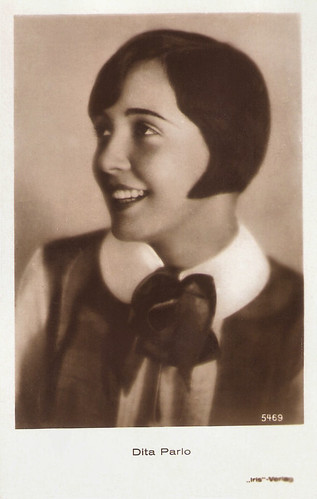
Austrian postcard by Iris-Verlag, no. 5469.

Belgian postcard by S.A. Chocolat & Cacao, Kivou, Vilvo(o)rde. Photo: Ufa.

German collector card by Ross Verlag in the series Vom Werden deutscher Filmkunst - Der Stumme Film, picture no. 107, group 43. Photo: Ufa. Dita Parlo and Lars Hanson in Heimkehr / Homecoming (Joe May, 1928).
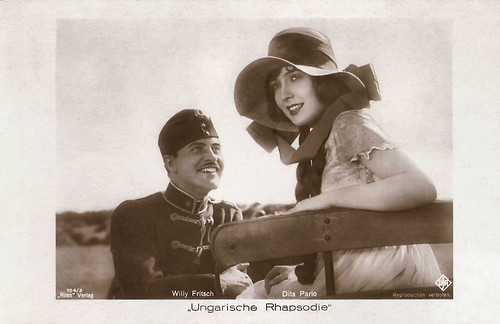
German postcard by Ross Verlag, no. 104/3. Photo: Ufa. Publicity still for Ungarische Rhapsodie / Hungarian Rhapsody (Hanns Schwarz, 1928) with Willy Fritsch.
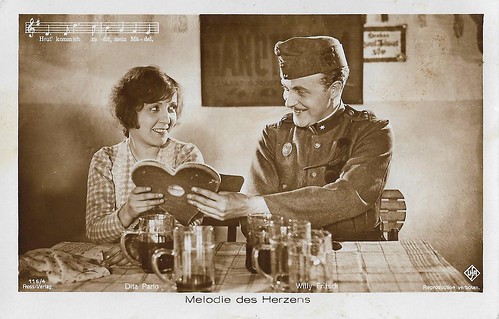
German postcard by Ross Verlag, no. 116/4. Photo: Ufa. Willy Fritsch and Dita Parlo in the German early sound film Melodie des Herzens / Melody of the Heart (Hanns Schwarz, 1929).

Dutch postcard by De Rolprent. Ivan Mozzhukhin and Dita Parlo in Manolescu - Der König der Hochstapler (Viktor Tourjansky, 1929).
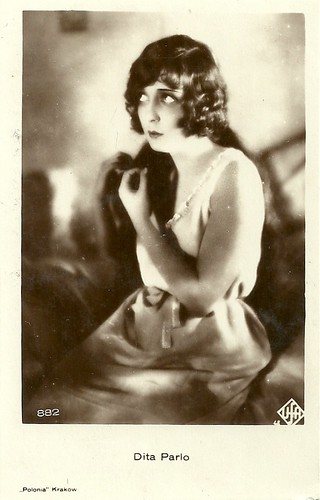
Polish postcard by Polonia, Krakow, no. 882. Photo: Ufa
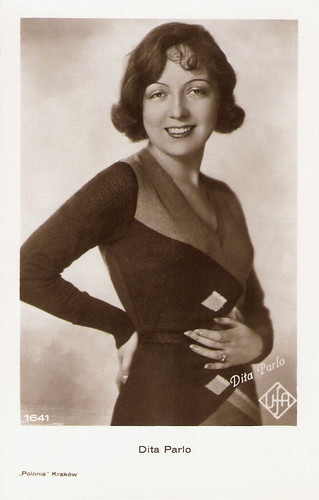
Polish postcard by Polonia, Krakow, no. 1641. Photo: Ufa.
Hollywood
Dita Parlo appeared in the first sound film of the Ufa, Melodie des Herzens / Melody of the Heart (Hanns Schwarz, 1929) opposite Willy Fritsch.
In France, she also became popular and appeared in Au bonheur des dames / For the Happiness of Women (Julien Duvivier, 1930), an adaptation of Emile Zola's 1883 novel of the same name.
In 1931, she tried her luck in Hollywood. She often appeared in German-speaking versions of American films, and she played parts in the minor films Honor of the Family (Lloyd Bacon, 1931) with Bebe Daniels, and the comedy anthology Mr. Broadway (Johnnie Walker, 1933). The sketch with Parlo in the latter film was taken from an uncompleted film by Edgar G. Ulmer, titled Love's Interlude. This film was begun in 1932 at Peerless Productions.
After two years in Hollywood and no success, Dita Parlo moved to Paris. She married a Frenchman and would make only French films for the rest of her career.
Later, she was scheduled to appear in the proposed Orson Welles production of Joseph Conrad's Heart of Darkness for RKO Radio Pictures. However, that project did not come to pass, and Welles began work on Citizen Kane.

German postcard by Ross Verlag, no. 3508/1, 1928-1929. Photo: Suse Byk, Berlin.
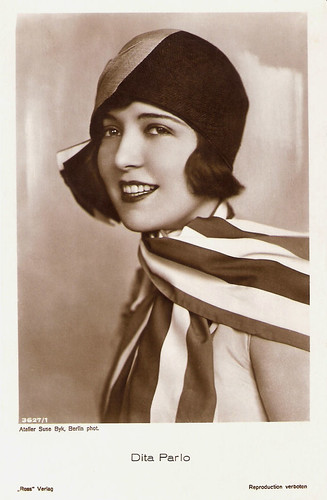
German postcard by Ross Verlag, no. 3627/1, 1928-1929. Photo: Atelier Suse Byk, Berlin.

German postcard by Ross Verlag, no. 4100/1, 1929-1930. Photo: Paramount.

German postcard by Ross Verlag, no. 4100/1, 1929-1930. Photo: Ufa.

German postcard by Ross Verlag, no. 4382/1, 1929-1930. Photo: E.O. Hoppé, London.

German postcard by Ross Verlag, no. 4843/1, 1929-1930. Photo: Alex Binder.

German postcard by Ross Verlag, no. 5374/1, 1930-1931. Photo: Atelier Bieber, Berlin.
Paris
Dita Parlo starred as a provincial bride aboard a canal barge in the beautiful L'Atalante (Jean Vigo, 1934). She and her ship captain Jean (Jean Dasté) struggle through marriage as they travel on their barge L'Atalante along with the captain's first mate, Le père Jules (Michel Simon), and a cabin boy. Ben Parker at IMDb: "Finally saw Vigo's L'Atalante, his only feature film, which he reportedly could not complete before his death, and instantly it's one of my top favourite movies and easily one of the best pictures ever made. L'Atalante has everything going for it: it's sexy, romantic and incredibly funny. It's also immensely genuine"
Three years later, Dita Parlo played a peasant opposite Jean Gabin in another masterpiece La grande illusion / The Grand Illusion (Jean Renoir, 1937). Donald J. Lamb at IMDb: "It is a wonder to see a film from the 1930s so definite in its view and opinions, yet so touching and revelatory. Jean Renoir's The Grand Illusion is a film of great importance, one that improves with each viewing."
After La grande illusion, Parlo appeared in eight more French films. She featured in the Spy film Mademoiselle Docteur / Street of Shadows (G. W. Pabst, 1937). She also co-starred with Erich von Stroheim in the historical drama Ultimatum (Robert Wiene, 1938). It was the final film of Wiene, who had been a leading director of German cinema, particularly noted for his work on expressionist films during the silent era. He died shortly before the film's completion, and it was finished by Robert Siodmak.
Following the outbreak of World War II, Dita Parlo was forced to return to Germany because of her nationality. That was the end of her film career. In 1949, she married a priest, Franck Gueutal. During the last thirty years of her life, she worked as a writer and appeared in only three films in small parts.
She made her final film appearance as a countess who always wins at gambling in La dame de pique / The Queen of Spades (Léonard Keigel, 1965), based on the story 'Pikovaya dama' by Alexander Pushkin. The countess had previously been given the secret that she can never reveal, and a poor Russian officer (Michel Subor) tries to force her hand with tragic results.
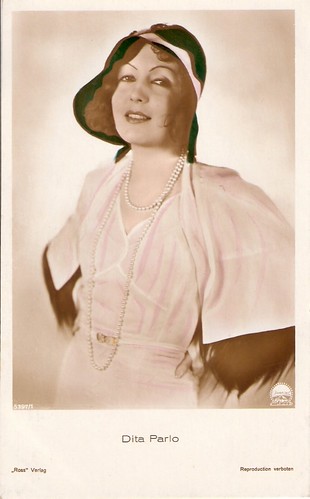
German postcard by Ross Verlag, no. 5397/1, 1930-1931. Photo: Paramount.

German postcard by Ross Verlag, no. 5496/1, 1930-1931. Photo: Atelier Manassé, Wien (Vienna).
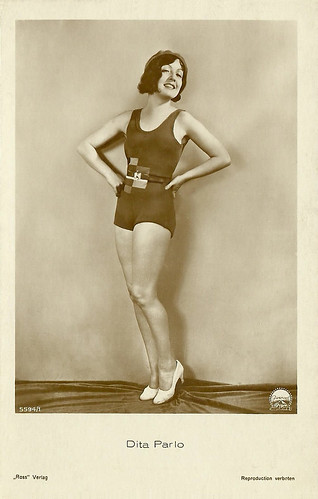
German postcard by Ross Verlag, no. 5594/1, 1930-1931. Photo: Paramount. Collection: Didier Hanson.
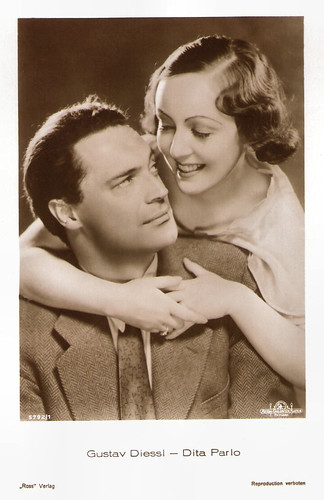
German postcard by Ross Verlag, no. 5792/1, 1930-1931. Photo: Metro-Goldwyn-Mayer. Publicity still for Menschen hinter Gittern (Pál Fejös, 1930) with Gustav Diessl. This was the German language version of The Big House (1930). Pál Fejös or Paul Fejos was a Hungarian-born, multi-lingual director who worked at MGM at the time. He was assigned to direct both German- and French-language 'parallel versions' of The Big House, using different actors but the same costumes and sets at MGM.

German postcard by Ross Verlag, no. 6248/1, 1931-1932. Photo: MGM.
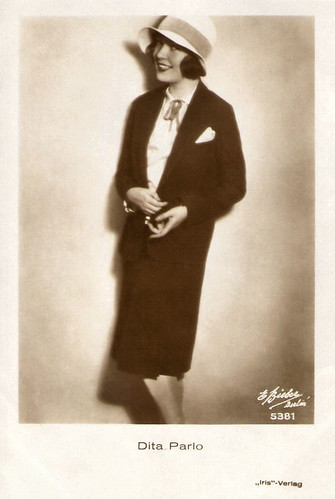
Austrian postcard by Iris Verlag, no. 5381. Photo: E. Bieber, Berlin.

Austrian postcard by Iris Verlag, no. 6093. Photo: Metro-Goldwyn.
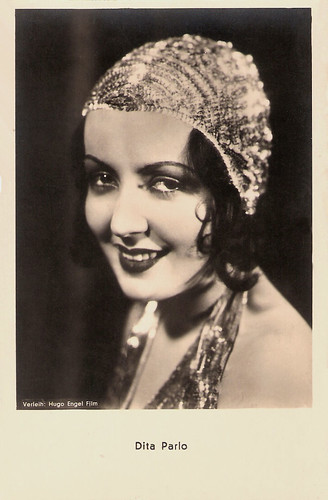
Austrian postcard by Iris-Verlag, no. 6687. Photo: Verleih Hugo Engel Film.
Burlesque
Dita Parlo died in 1971 in Paris. She was 65.
Parlo left strong impressions on all who caught her work. In 1992, Madonna said she was fascinated by Parlo. Madonna picked her name as an alias while touring and booking into hotels.
Madonna took her name again for the character she created for her legendary 'Sex' book and 'Erotica' album. Its title track commences with the line "My name is Dita, I'll be your mistress tonight... ".
Burlesque performer Dita Von Teese took her first name also in tribute to Dita Parlo.
Musician Steve Adey has a song called 'Dita Parlo' on his studio album The Tower of Silence (2012). The song was written in response to L'Atalante.
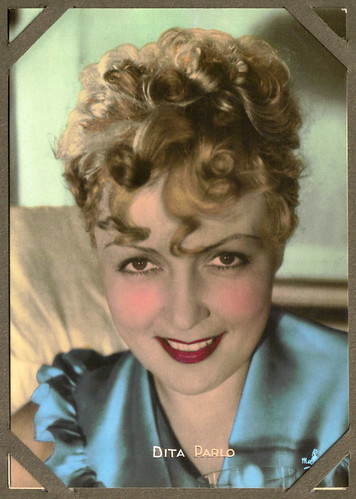
French card by Massilia. Collection: Amit Benyovits.
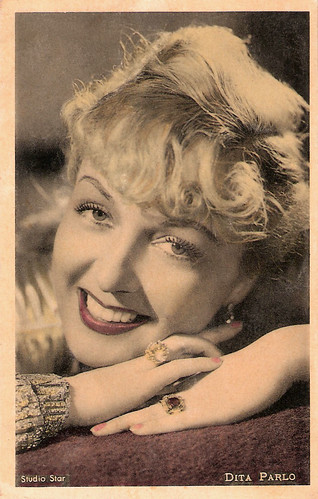
Vintage postcard. Photo: Studio Star.
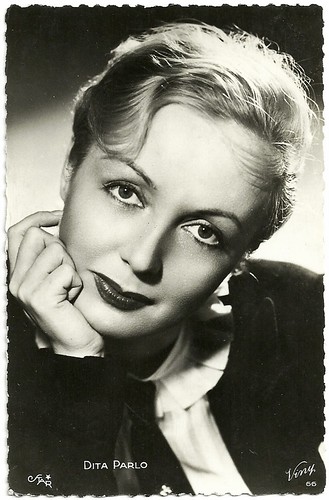
French postcard by Viny, no. 66. Photo: Star.

French postcard by Editions P.I., Paris, no. 104. Photo: Star. Publicity still for La Grande Illusion (Jean Renoir, 1937).

French postcard by EPC (Editions et Publications cinématographiques), no. 203. Photo: Studio Star.

French postcard by Europe, no. 1086. Photo: Studio Intran.
Trailer for L'Atalante (1934). Source: BFI Trailers (YouTube).
Trailer of La Grande Illusion (1937). Source: Danios12345 (YouTube).
Sources: Thomas Staedeli (Cyranos), Operator 99 (Allure), Sandra Brennan (AllMovie - Page is now defunct), Filmportal.de, IMDb and Wikipedia.
No comments:
Post a Comment